Among the four major Japanese bikemakers, Kawasaki has been the latest to update its flagship track-tool. However, the 2021 Kawasaki Ninja ZX-10R is here and alongside, the limited-run ZX-10RR has been unveiled too. With this update, the bike gets updated hardware, and design which is more of an evolution of the outgoing bike’s appearance rather than something revolutionary. The hardware updates are substantial though and it has all been done to continue the factory team’s dominance in the WSBK series.
The new 2021 Ninja ZX-10R, Ninja ZX-10R KRT Edition and Ninja ZX-10RR get an all-new aerodynamic body which focuses on function more than form. They get integrated winglets, small and light LED headlights, (much needed) TFT colour instrumentation, and Smartphone Connectivity. Kawasaki engineers have made several changes to the engine and chassis for 2021. Kawasaki hasn’t revealed power figures officially, however, the ZX-10R now makes 203 PS while the RR version makes a little more as it also runs a 4,000 rpm increased rev limit.
2021 NINJA ZX-10R HIGHLIGHTS
- Updated Engine and Air-cooled Oil Cooler
- NEW Light Handling Chassis
- NEW Suspension Settings
- NEW Next Generation Aerodynamic Ninja Styling featuring Integrated Winglets
- Updated Riding Position
- NEW Electronics
- High-performance Brembo Brake System
- NEW Electronic Throttle Valves
- NEW Exhaust System
- NEW Transmission Gear Ratios
The engine of the 2021 Ninja ZX-10R receives several updates for 2021 to offer cleaner emissions and maintain the performance of its predecessor. The 998cc in-line four-cylinder 16-valve engine balances power with manageability. Like the older bike, positioning peak torque high up in the RPM range makes it easier for riders to get back on the throttle with confidence, while a strong low-mid range further contributes to acceleration when coming out of corners.
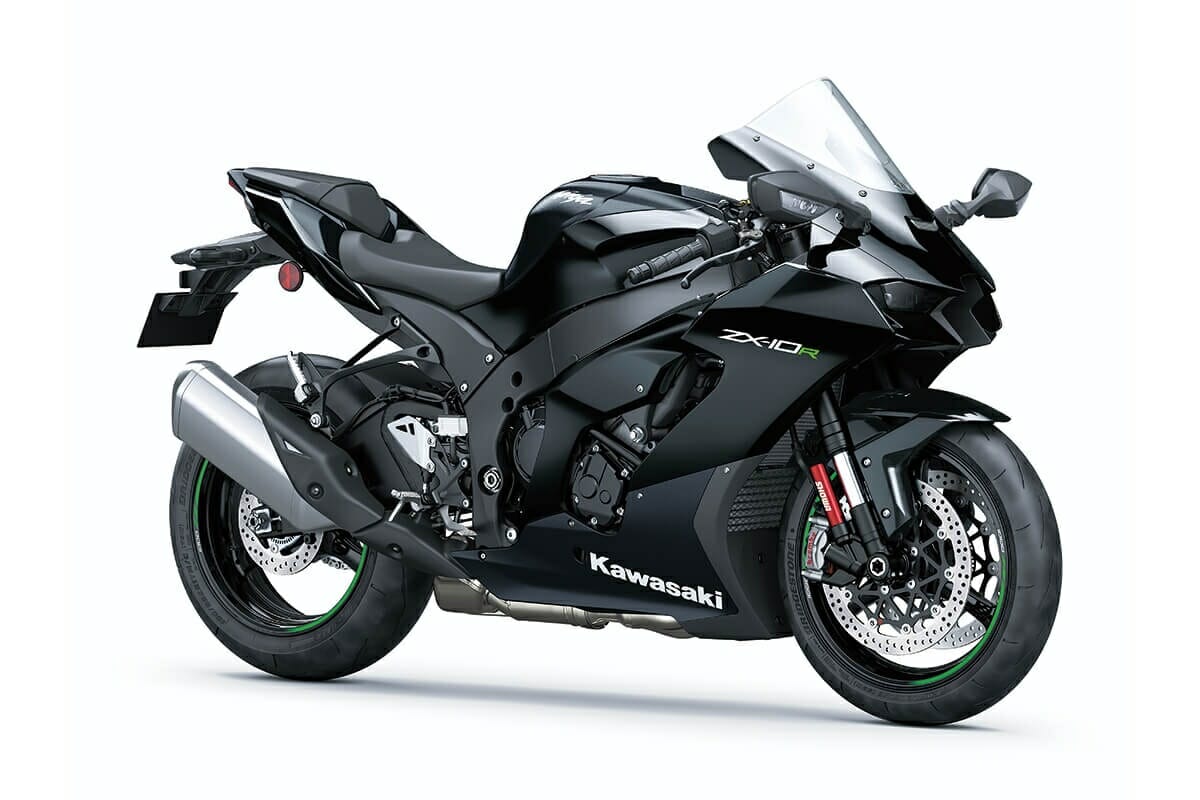
Utilizing feedback derived directly from Kawasaki’s factory WorldSBK team, state-of-the-art machining technology is used in the design of the intake ports, which is done in two stages to create a straighter path for intake air as it enters the combustion chamber. This design promotes smoother flow and a greater volume of fuel-air mixture, both greatly contributing to performance. The finger-follower valve train designed by Kawasaki’s World Superbike engineers brings top-level racing technology to the Ninja ZX-10R platform. The valve train design enables tuning for a higher rev limit and more aggressive cam profile, aiding in high RPM performance. A Diamond-Like Carbon (DLC) coating is used on the finger-followers and helps protect against wear.
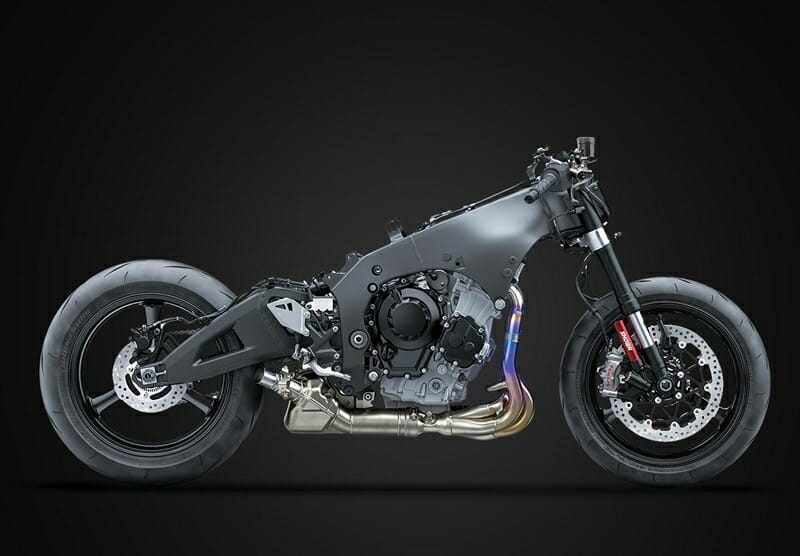
Titanium intake and exhaust valves ensure high heat resistance and low reciprocating weight. The cylinder head provides plenty of camshaft clearance and large coolant passages in the cylinder contribute to cooling performance for optimum performance. Lightweight Chromoly camshafts received a soft nitriding treatment and the cam portions receive a lapping treatment to ensure the durability needed to handle the stiff valve springs and high power cams and speed of the Ninja ZX-10R sportbike. The pistons are made from a high heat resistant material and a dry film lubricant on the piston skirts reduces friction at low RPM and helps with the piston bedding-in process.
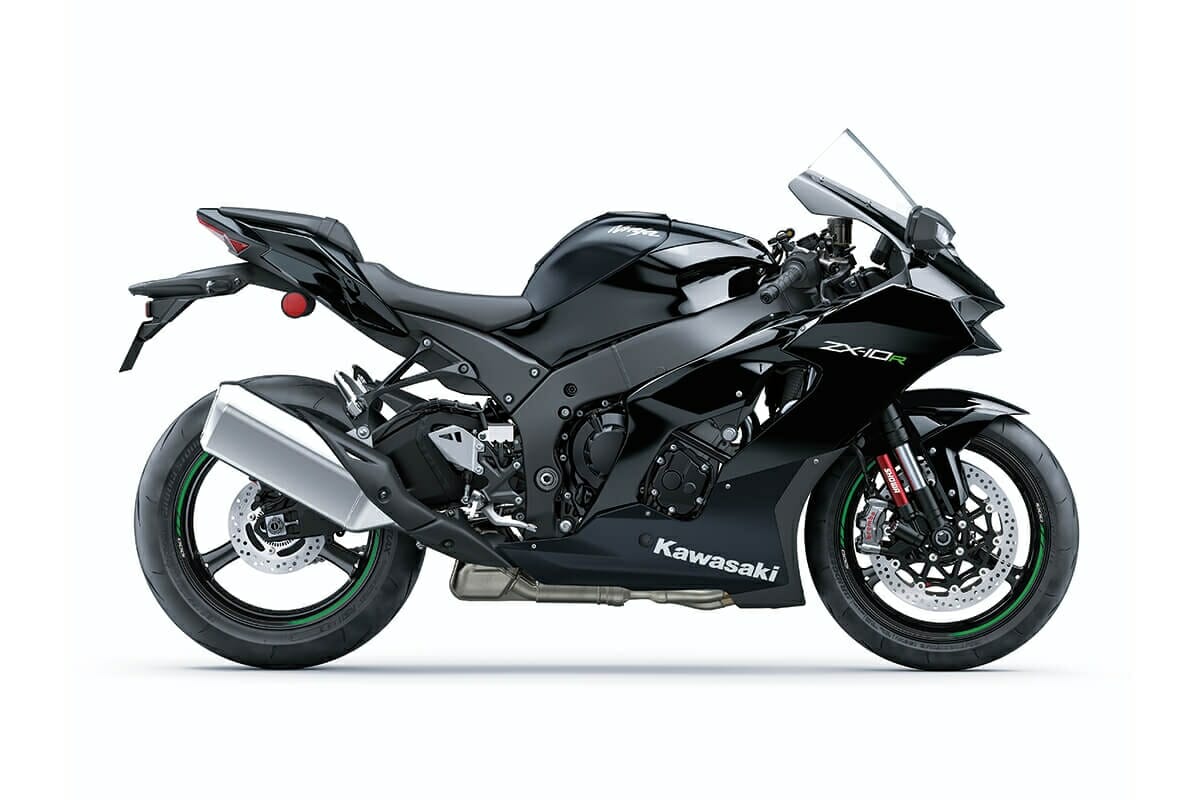
Kawasaki’s fully electronic throttle actuation system enables the ECU to control the volume of both fuel and the air delivered to the engine. Ideal fuel injection and throttle valve position result in smooth, natural engine response and optimized engine output. The accelerator position sensor was relocated for 2021, eliminating the throttle cable for less maintenance and freeing up the cockpit. To ensure a natural feel, friction is used to simulate the feel of a throttle cable.
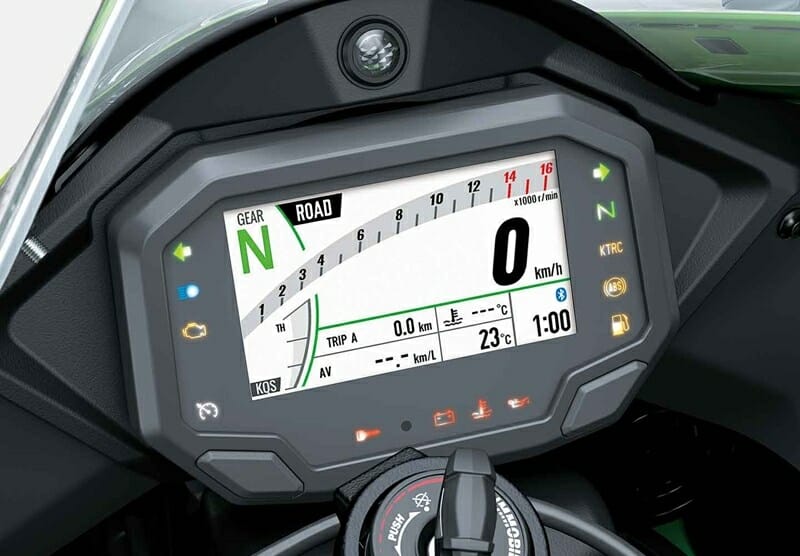
On the bottom end, the crankshaft features low inertia, benefitting the bike’s overall performance with acceleration, deceleration, and cornering. An offset cylinder matches the crankshaft and results in reduced lateral piston force at the point of maximum combustion pressure as well as enables the use of lighter pistons. The close-ratio transmission gearing on the Ninja ZX-10R has been revised and optimized for the days at the racetrack. The final gearing has been revised and shorter ratios for first, second, and third gears offer strong low-mid acceleration for quicker corner exits and better off-the-line acceleration.
Similar to that found on Kawasaki’s WorldSBK race machine, and new for 2021, is an air-cooled oil cooler that is seen on high-performance models. Instead of re-routing coolant from the radiator to the oil-cooler and back to the engine, the new oil cooler is air-cooled and runs independently. This design allows oil to be routed from the left lower crankcase to the oil cooler, where it’s cooled, then returned on the right side. The increased cooling boosts engine performance increases throughout the entire rpm range. In order to meet emission standards, the exhaust system benefits from several changes that include a revised collector pipe arrangement, which helps maintain the engines power output. For improved performance and cleaner emissions, engineers also moved one of the catalysers further forward and decreased pre-chamber volume while increasing the silencers overall length.
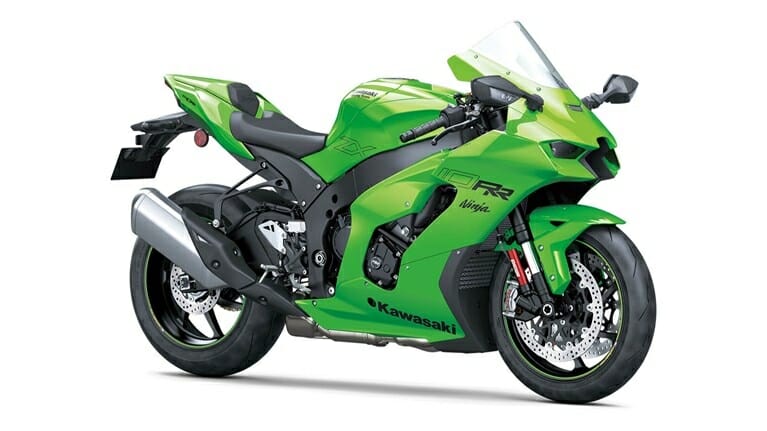
The Ninja ZX-10R now features Kawasaki Cornering Management Function (KCMF), Bosch IMU, Sport-Kawasaki Traction Control (S-KTRC), Kawasaki Launch Control Mode (KLCM), Kawasaki Intelligent anti-lock Brake System (KIBS), Kawasaki Engine Brake Control, Kawasaki Quick Shifter (KQS), Ohlins Electronic Steering Damper and Power Modes. New for 2021 are Integrated Riding Modes, Electronic Cruise Control, TFT Color Instrumentation, and Smartphone Connectivity. Adding to its list of high-performance features, the Ninja ZX-10R comes equipped with dual-direction KQS. The KQS allows ultra-quick upshifts and downshifts without the need to use the clutch, resulting in a more enjoyable experience and quicker lap times. Designed for more effective sport riding, KQS can also be used on the street when the engine is above 2500 rpm.
Using the latest evolution of Kawasaki’s advanced modelling software and feedback from a compact IMU that gives an even clearer real-time picture of chassis orientation, KCMF monitors engine and chassis parameters throughout the corner – from entry, through the apex, to corner exit – and when working in conjunction with KIBS modulate brake force and engine power to facilitate a smooth transition from acceleration to braking and back again, and to assist riders in holding their intended line through the corner. The systems that KCMF oversees on the Ninja ZX-10R includes S-KTRC, KLCM, KIBS, and Kawasaki Engine Brake Control.
The S-KTRC featured on the Ninja ZX-10R motorcycle has five modes for riders to choose from that enable optimal performance for a wide range of riding conditions, offering either enhanced sport riding performance or the peace of mind under certain conditions to negotiate a variety of surfaces with confidence. The system can also be turned off if the rider elects to do so.
There are updates to the chassis geometry, which moves the front-rear balance further forward and contributes to increased cornering performance and light handling. The aluminium twin-spar frame traces a direct line from the head pipe to the aluminium swingarm pivot, delivering linear behaviour and greater control. New for this year, the swingarm pivot position has been lowered 1 mm to produce better rear suspension action when exiting corners. A longer wheelbase achieved by a greater fork offset and an 8mm longer swingarm offers even greater overall composure– already a strength on the Ninja ZX-10R. A shorter trail is achieved thanks to the revised fork offset and facilitates in an easier change of direction, especially when off the throttle before the apex of a corner.
Handling the front suspension duties is an advanced Showa Balance Free Front Fork (BFF) that has been developed with technology straight from Kawasaki’s WorldSBK factory racers. The 43 mm Showa fork is independently adjustable for compression and rebound damping. The 2021 model features a new wider fork clamping area on the lower triple clamp and revised rigidity balance for the fork outer tubes improve handling and turning performance. New circuit-focused fork settings include a lower spring rate, complemented by firmer compression damping and softer rebound damping to make it easier to weight the front wheel and contribute to lighter handling.
Horizontal back-link rear suspension and a Showa Balance Free Rear Cushion (BFRC) rear shock hold up the rear-end. The Showa BFRC high spec shock increases ride comfort, improves traction, offers independently adjustable compression and rebound damping, and reduces weight. In order to enhance rider comfort and complement the 2021 Ninja ZX-10R’s aerodynamic package are several updates, beginning with a new, taller windshield that is set at a steeper angle. A revised handlebar position is now farther forward and straighter. A benefit of having more space between the handlebars and the seat is the ability to change positions for both track and street riding.
An increase of height has been made to the rear of the rider’s seat, encouraging riders to elevate their hips when in a full race crouch position. This position helps minimize drag when tucked behind the windshield. Footpegs are now positioned 5mm higher in order to meet the circuit-focused riding position that engineers sought after. The higher position makes it easier to weight the pegs when going through a corner.
The Integrated Riding Modes now allow for riders to choose from three pre-determined modes (Sport, Road, Rain) or four manual modes (Rider 1-4) and feature the ability for changes to be made while riding through the use of a button located on the left handlebar. A new Electronic Cruise Control is also accessed conveniently from the left side of the handlebar, allowing for desired speed to be selected and it can easily be disengaged by operating the brake lever, clutch lever, brake pedal, closing the throttle completely or when shifting gears. The update ZX-10R also gets front Brembo M50 brake calipers which bite into a pair of 330 mm Brembo semi-floating front discs. At the rear, a 220 mm disc and single-piston caliper complement the strong front brake and feature revised rear brake pads. Three-spoke design cast wheels are light weight and provide the optimum rigidity to contribute to edge grip when riding on the track.
A new 4.3” all-digital TFT colour instrumentation adds to the Ninja ZX-10R’s high-grade appearance with a full-colour display. Another new feature is smartphone connectivity which allows riders to connect to their motorcycle wirelessly via a Bluetooth chip built into the instrument panel. Utilizing the smartphone application “RIDEOLOGY THE APP”, a number of instrument functions can be accessed to enhance the riding experience.
The screen’s background colour is selectable in either black or white and the screen brightness automatically adjusts to suit the available light. Display functions have been updated to include a digital speedometer, digital bar-style tachometer, gear position indicator, throttle application, odometer, dual trip meters, current and average fuel consumption, the volume of fuel consumed, low fuel indicator, average speed, total time, coolant temperature, intake air temperature, clock, battery voltage, Kawasaki service reminder, oil change reminder, call and mail indicators (when connected to Bluetooth), and economical riding indicator.
In addition to scrollable multi-function windows, two display modes offer riders a choice of how they want their information presented. Type 1 is easy-to-read, offering a calm layout and substantial amount of information at a glance, while Type 2 was designed with circuit-riding in mind and includes important information such as tachometer, current and best lap times, gear position, and is presented graphically. An external race-style shift lamp provides the rider with a highly visible signal to shift up when riding on the circuit.
2021 Kawasaki Ninja ZX-10 RR
For 2021, in addition to the many engine, suspension, and chassis changes shared with the Ninja ZX-10R, the basis for the World Championship-winning superbike is the Single-seat Ninja ZX-10RR model which features several special updates that were developed through Kawasaki’sracing efforts in WorldSBK.
The engine updates add a tremendous racing potential including the elimination of intake funnels in the airbox, newly designed camshafts specific for the Ninja ZX-10RR, and intake and exhaust valve springs that all match the higher performance. The use of lightweight titanium connecting rods manufactured by Pankl, a company specializing in developing and manufacturing engine and drivetrain components for high-performance race cars and the aerospace industry, is one of the key performance features found on the Ninja ZX-10RR. The motor on the ZX-10RR makes slightly more power than it does for the one with one ‘R’ less.
New, lighter weight pistons lower the reciprocating weight, aiding in the high rev limit and contributing to smooth-climbing revs. Now using one less piston ring than the standard model pistons, this enables a shorter piston height and prevents mechanical loss due to friction. Updated piston pins match the pistons and feature a DLC coating that protects against wear. The 2021 Ninja ZX-10RR features new Pirelli Diablo Supercorsa SP tires that are fitted to forged Marchesini wheels that were designed to specifically meet the needs of the powerful engine. It’s available in a bold paint scheme in Lime Green. Both machines proudly wear the brand’s river mark which is first for a non-supercharged Kawasaki bike.
